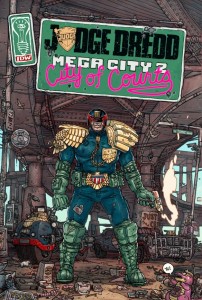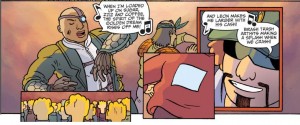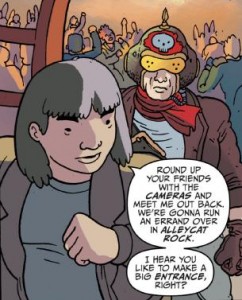 Judge Dredd Mega-City Two: City of Courts (TPB)
Judge Dredd Mega-City Two: City of Courts (TPB)
Douglas Wolk (W)
Ulises Farinas (A)
IDW
Judge Dredd Mega-City Two: City of Courts does what so many other Dredd stories have done—take Dredd, stick him somewhere that isn’t Mega-City One, and watch the culture shock unfold—but with panache and a firsthand cultural understanding that make it stand out in a canon that’s over three decades old.
The plot is basically this: Judge Dredd has been sent to Mega-City Two to unravel a conspiracy but finds himself at the center of a reality show about Judges hunting down criminals. Along the way he collars perps, shoots people and gets shot at, and tries to make sense of life in a strange city.
Here’s where the firsthand understanding first becomes apparent. Mega-City Two is essentially California, in the same way that Mega-City One is built on the post-nuclear war remains of New York and the upper Eastern seaboard. Having an author who is an American comics/cultural critic gets rid of the sense of detachment that is so often visible in 2000AD’s British-authored Dredd stories.
Although the tone of Mega-City Two is more clearly American than it is in 2000AD, Dredd’s voice never sounds out of character. Wolk—author of the Dredd Reckoning blog, which reviews Judge Dredd collections—is an obvious Dreddficionado, and this expertise shows in the dialogue.
Wolk also explores the hyper-performativity in American culture that is popularly seen as coming from California, and this is where the series’ trademark bite is most visible: the Citizenship Pageant for potential immigrants, who are admitted to the country based on how telegenic they look; or the Lawcon, where attendees dress as Judges and the Chief Judge’s love of PR over the law is revealed.
The workings of Mega-City Two are outlined via carefully labeled diagrams that remind me of those Complete Guide to [Franchise] books on nerd children’s bookshelves (okay, my bookshelves). The enthusiasm for getting to build part of Dredd’s world is clear and infectious.
On a less analytical note, there’s a delightfully disgusting bit where Dredd battles a huge radiation-mutated creature that eats people; I don’t go for monster stories as a whole, but for some reason I quite enjoy reading them when Judge Dredd is involved.
Another feature of Judge Dredd is its callbacks to (in)famous public figures in background art the names of buildings and streets; to my recollection, Mega-City Two is the first Dredd story arc in which those public figures aren’t white, hence the Suge Knight Federal Bank and a poster advertising the James Brownotron.
At one point, we’re treated to a spot-on parody of the “California Love” music video, complete with Tupac and George Clinton look-alikes, which is the best reference to popular music in all of Judge Dredd. (The less said about Garth Ennis’s Muzak Killer and his sidekick Indie Saddo, the better.) 
Not only is this parody amazing, but the specific selection of this song makes sense: the video takes place in the year 2095, and the world of Dredd is one in which the events of the “California Love” video could actually happen.
It’s all rendered in Farinas’s art, which is always a pleasure to look at. In this case, though, it makes Mega-City Two look overly friendly; characters are drawn with rounded lines, giving them a cuddly appearance that’s out of place in Dredd’s grim future. The colors are also too cheery, to the point where it always seems to be daytime.
If the intent was to portray a city where the sun never sets (and since the Mega-Cities are climate-controlled, that’s entirely feasible), then I would have wanted more garish colors that punch you in the eyes with their brightness. Dredd’s world should make the reader feel constantly on edge; this is a future that we hope never comes to pass.
The story raises several interesting points that could have been explored further. The relationship between the Mega-Cities’ mass media and their citizens is a recurring theme in Judge Dredd, and I would have liked to see more of it in Mega-City Two. While the reality show starring Dredd runs throughout the story, it doesn’t exactly have a futuristic feeling—mostly because a show built around officers of the law catching criminals already exists in the real world in the form of COPS. Highlighting the citizens’ interactions with the show would have added more, as would higher, more violent stakes; I was expecting more viewers voting for perps to get shot in the face.
I also wanted to see the effects of the socioeconomic forces that led to a federal bank being named after Suge Knight. If the cultural semi-underground of hip-hop is now the establishment, wouldn’t that be reflected in the media and landscape? Returning to “California Love” for a moment, the song doesn’t deal with the glitz of white SoCal, but rather the grit of Watts, Oakland, Inglewood, and Compton (and the video itself is set in Oakland): culturally significant parts of California that aren’t visible in Mega-City Two. If these elements had been more prominent in the city, it would have been a more original concept.
The opening line of “California Love” describes California as “the Wild Wild West.” We get a taste of that when Dredd goes to Melody Time, a lawless district whose economy is dependent upon the merchandising of Looney Tunes-esque characters, but that’s about it. The legendary anarchy of the Wild West is only really seen in the relative fearlessness of Mega-City Two’s wrongdoers, who enjoy the exposure afforded when they’re caught by Judge Dredd on camera.
Mega-City Two has the potential to take IDW’s treatment of Judge Dredd in an intriguing direction that portrays the diverse foundations of contemporary American culture. However, the concepts shaping these portrayals need to be dealt with in more depth if this potential is to be achieved.

